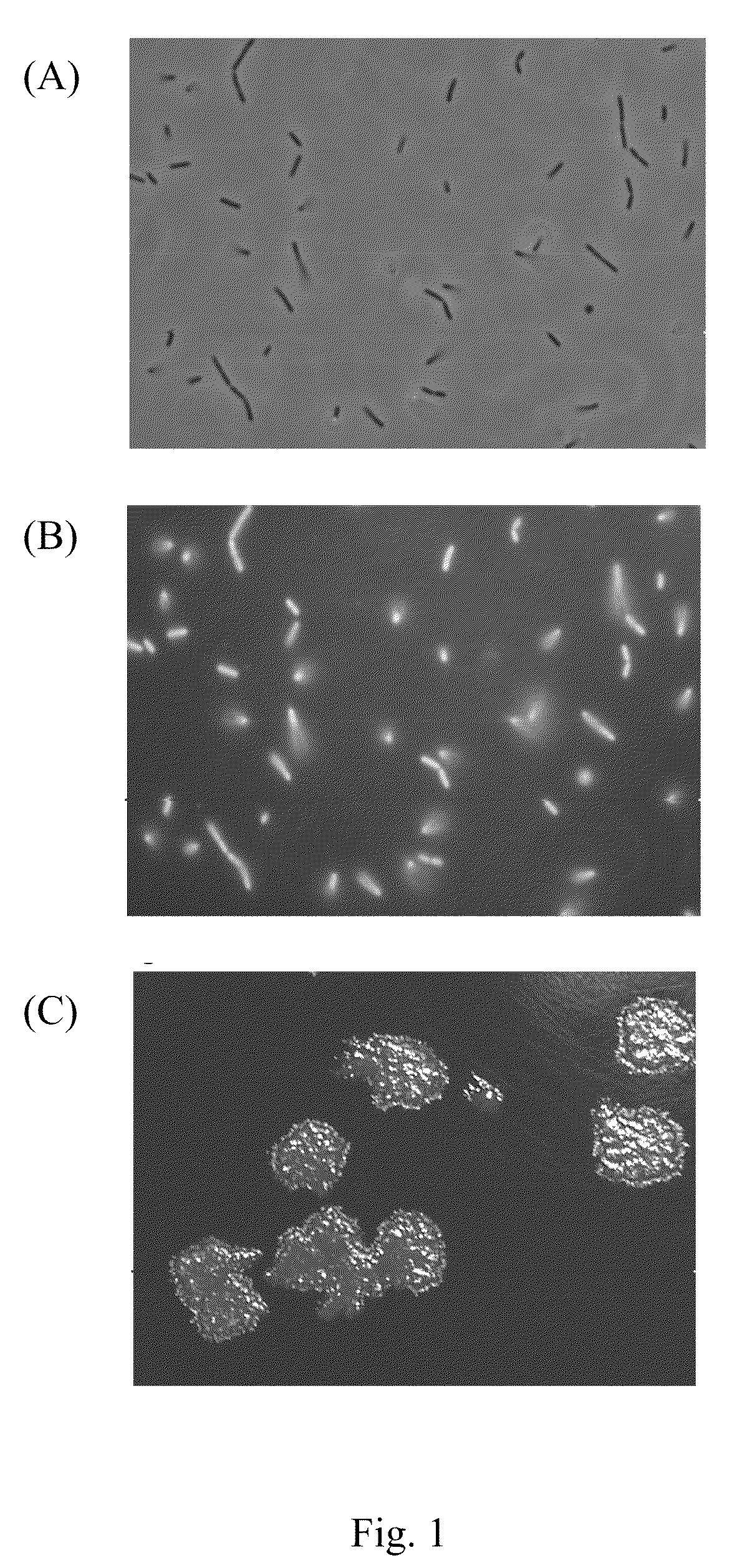Bacillus Licheniformis and Method for Detoxification of Zearalenone
- Summary
- Abstract
- Description
- Claims
- Application Information
AI Technical Summary
Benefits of technology
Problems solved by technology
Method used
Image
Examples
example 1
Morphological and Molecular Identification of Bacillus licheniformis CK1
(1) Strains
[0023]The novel strain CK1 was isolated from soils in Experimental Farm College of Bio-Resources and Agriculture, National Taiwan University according to Petchkongkaew et al. (2008). Single colonies screened from samples were transferred to LB (Luria-Bertani) agar plate (Difco Laboratories) containing 0.5% (w / v) oat spelt xylan (Sigma-Aldrich Co.) at 37° C. cultivated for 24 h, followed by xylanase assay with Congo Red plate staining A yellow ring resulting from xylan hydrolysis appeared around positive colonies. Bacillus licheniformis CK1 in the present invention showed the highest level of xylanase activity was selected for further analysis.
[0024]Bacillus licheniformis ATCC 14580 was purchased from American Type Culture Collection (ATCC, Manassas, Va.) as a control. All the strains were cultivated in LB at 37° C. Agar plates were prepared by adding agar in the ratio of 1.5% W / V.
(2) Morphological Tra...
example 2
Extracellular Xylanase, CMCase, and Protease Activity of Bacillus licheniformis
[0029]Overnight culture of strains CK1 and ATCC 14580 were transferred into 10 ml of LB broth in a ratio of 1% and cultivated at 37° C., 250 rpm for 16 h. The cell supernatents were collected after the centrifugation of 5,000×g for 20 min at 4° C., followed by radial diffusion method and enzyme assay.
Radial Diffusion Methods
[0030]The extracellular xylanase, CMCase, and protease activities of strains CK1 and ATCC 14580 were assayed using the radial diffusion methods (Teather and Wood, 1982; and Waldeck et al. 2006).
[0031]FIG. 3A showed the enzyme activities toward various substrates (xylan, carboxymethyl cellulose (CMC) and skim milk) of strains CK1 and ATCC 14580. The substrate in the medium would be degraded and displayed a clear zone when the bacteria had the enzyme activity. The strain CK1 showed higher activity toward xylan, carboxymethyl cellulose (CMC) and skim milk by showing a larger clear zone w...
example 3
Growth of Bacillus licheniformis Under the Influence of Zearalenone (ZEN)
[0036]Zearalenone (Sigma-Aldrich) was dissolved in DMSO as the stock solution. Growth of Bacillus licheniformis under the influence of ZEN was studied after 1% of CK1 or ATCC 14580 overnight culture was inoculated into 10 ml of LB broth either containing 2 ppm ZEN or not and incubated at 37° C. with shaking at 250 rpm for 48 h respectively. Samples were taken every 4 h to determine the cell number using standard agar plate count and OD600 measurement.
[0037]The strain CK1 reached stationary phase with the cell number of 9.17±0.14 log CFU ml−1 (OD600: 2.09±0.02) after incubated in LB at 37° C. for 24 h. ATCC 14580 strain showed similar result as the CK1 strain. No significant difference between the cell counts of CK1 and ATCC 14580 during fermentation.
[0038]The growth of the strain CK1 and ATCC 14580 showed similar trends when cultivated in LB broth either containing 2 ppm ZEN or not. This indicated that ZEN has ...
PUM
 Login to View More
Login to View More Abstract
Description
Claims
Application Information
 Login to View More
Login to View More - R&D
- Intellectual Property
- Life Sciences
- Materials
- Tech Scout
- Unparalleled Data Quality
- Higher Quality Content
- 60% Fewer Hallucinations
Browse by: Latest US Patents, China's latest patents, Technical Efficacy Thesaurus, Application Domain, Technology Topic, Popular Technical Reports.
© 2025 PatSnap. All rights reserved.Legal|Privacy policy|Modern Slavery Act Transparency Statement|Sitemap|About US| Contact US: help@patsnap.com



